





I've always wanted to have my own snowdrops in my garden. Just seeing this beautiful, tiny flower popping up from under the snow brings me hope that spring is coming--its purity and spring scent always brings joy to my heart. I was surprised when a friend didn't know what a snowdrop looked like! That's when I decided to write about this plant that brings joy to northern "peeps" each spring!
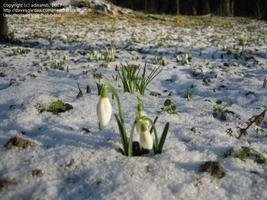
Romania is situated in a temperate zone and its citizens experience all four seasons. After a long cold winter, snowdrops are popping up and then we know spring is near.
Snowdrops are perennial bulbs from the Amaryllidaceae family, genus Galanthus. They are very hardy bulbs, being the first to bloom of all bulbs, even before spring comes.
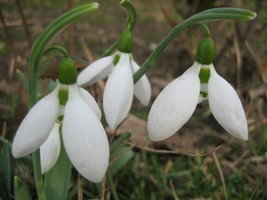
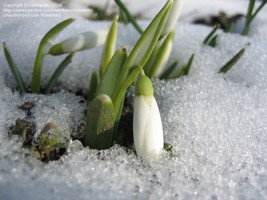 Snowdrops have thin, long leaves and a pendulous, bell flower on each stalk. The flower is held by a very thin pedicel, coming out from the stalk. A pair of very peculiar bracts, called spathe valves, are holding the bud. After it blooms, the bracts remain erect, looking like another leaf, but much shorter. The flower's petals are called tepals. The tepals are undifferentiated petals and sepals, all having the same color and appearance. Many bulbs have tepals, including amaryllis, tulips, hellebores and anemones.[1]
Snowdrops have thin, long leaves and a pendulous, bell flower on each stalk. The flower is held by a very thin pedicel, coming out from the stalk. A pair of very peculiar bracts, called spathe valves, are holding the bud. After it blooms, the bracts remain erect, looking like another leaf, but much shorter. The flower's petals are called tepals. The tepals are undifferentiated petals and sepals, all having the same color and appearance. Many bulbs have tepals, including amaryllis, tulips, hellebores and anemones.[1]
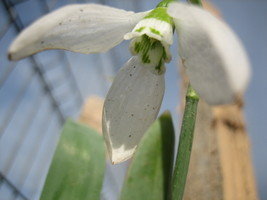
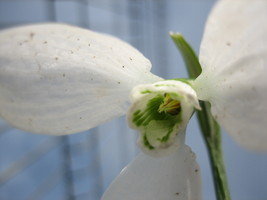
Snowdrop's flower has three larger outer tepals and three shorter inner tepals, which have the appearance of a tube, with a greenish line at the top of each tepal. Inside the “tube” is the ovary which contains white seeds with long white tails. The polination is made by ants who are attracted to the substance contained in the seeds .[1]
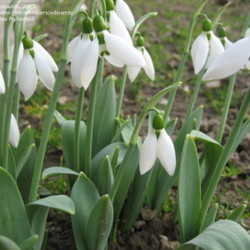
Leaves vary from one snowdrop variety to another and their appearance can make a difference in recognizing between each snowdrop species and variety.[1]
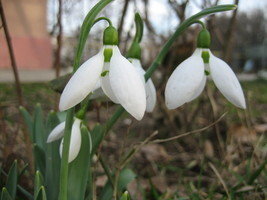
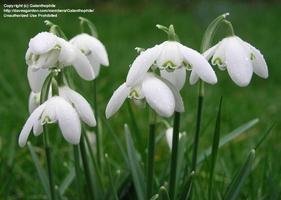 Propagation is easy: you can allow the bulbs to multiply each year or you can divide them into smaller clumps and replant them. Most snowdrops can also be grown from seeds. When you wish to divide the snowdrop bulbs, it's best to do it after their flowers dry up and they still have leaves. It's best to add some sand for drainage when planting the bulbs. Snowdrops grow well in a forest soil type, with leaf litter (duff) that never dries up during summer. If grown in the garden, they can be planted in a sunny location or even partially shaded, like under trees. They can be grown in pots too, as long as their growing needs are fulfilled.
Propagation is easy: you can allow the bulbs to multiply each year or you can divide them into smaller clumps and replant them. Most snowdrops can also be grown from seeds. When you wish to divide the snowdrop bulbs, it's best to do it after their flowers dry up and they still have leaves. It's best to add some sand for drainage when planting the bulbs. Snowdrops grow well in a forest soil type, with leaf litter (duff) that never dries up during summer. If grown in the garden, they can be planted in a sunny location or even partially shaded, like under trees. They can be grown in pots too, as long as their growing needs are fulfilled.
Snowdrops are native to all Europe from the Mediterranean Sea to Great Britain, where they say the Romans might have introduced them.[1]
There are many varieties of Galanthus, although over-collecting from the wild has led to their inclusion on the Convention on International Trade in Endangered Species (CITES) list of endangered plants. Some varieties bloom in January, others in February. Here are a few of the most-popular species and varieties.
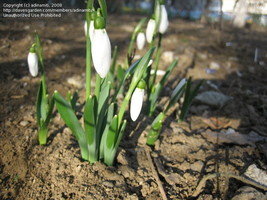
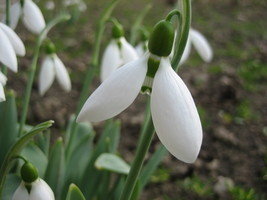
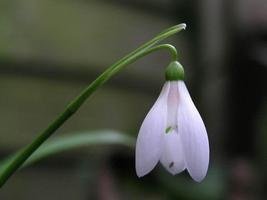
Galanthus nivalis Galanthus elwesii Galanthus ikarie
Galanthus nivalis or common snowdrop is the most popular variety, but also the smallest snowdrop, growing up to 3-6 inches (7-15 cm) tall and popping up from January until March.
Galanthus elwesii or giant snowdrop is the most spectacular snowdrop, with the largest flowers which have a sweet scent. The tube has a greenish line at the bottom too, not only at the top. It grows up to 12 inches (30cm) tall and blooms in January to February. It originates from Turkey.
Galanthus ikariae also originating from Turkey, is hardy in dry climate. The flowers have a lantern shape and the leaves are wider.
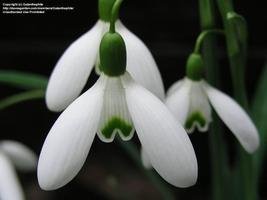

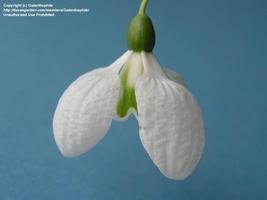
Galanthus 'Sam Arnott' Galanthus 'Magnet' Galanthus plicatus 'Augustus'
Galanthus 'Sam Arnott' has flowers twice as big as the usual G. nivalis and a subtle scent. It grows up to 6 to 12 inches (15-30cm).
Galanthus 'Magnet' is a very hardy snowdrop variety with large flowers; it tends to multiply quickly.
Galanthus plicatus 'Augustus' grows up to 12 inches tall (30cm), has fuzzy outer tepals and blooms in January-March.
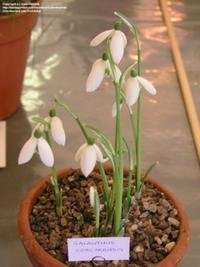
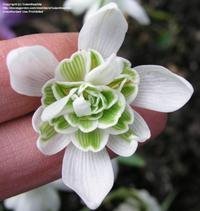
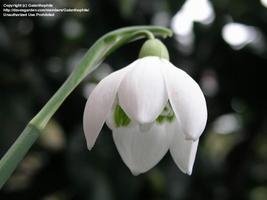
Galanthus corcyrensis Galanthus 'Flore pleno' Galanthus 'Hill Poe'
Galanthus corcyrensis is suitable to grow in containers.
Galanthus nivalis 'Flore Pleno' and Galanthus 'Hill Poe' are double snowdrops; both have double flowers and propagate easily. The only difference between them is the number of the outer tepals: four for the 'Flore Pleno' and five for 'Hill Poe'.
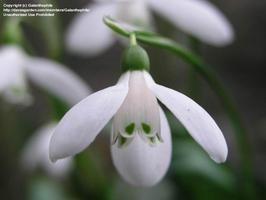
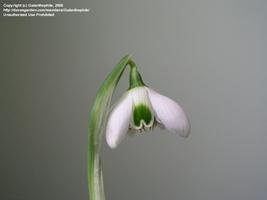
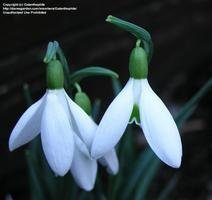
Galanthus woronowii Galanthus 'Ophelia' Galanthus 'Atkinsii'
Galanthus woronowii grows up to 6 to 12 inch(15-30cm), has wide-open flowers and beautiful foliage.
Galanthus 'Ophelia' has small flowers and short bracts.
Galanthus 'Atkinsii' has oblique bracts.
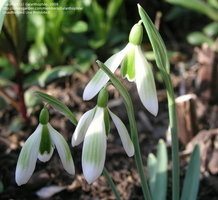 Galanthus nivalis 'Virescens' can be recognized by the greenish lines on both inner and outer tepals.
Galanthus nivalis 'Virescens' can be recognized by the greenish lines on both inner and outer tepals.
Galanthus caucasicus has grey leaves and big flowers. It blooms later than other varieties.
Galanthus plicatus originates from Russia and has curly leaves.
Galanthus nivalis 'Pagoda' has curled outer tepals .
Galanthus reginae-olgae and the subspecies vernalis are growing in southern Europe, Sicily and Greece. They are very similar to G. nivalis except they bloom in the fall.
Snowdrops can be easily mistaken with the snowflakes (Leucojum and Acis), very similar in appearance, but with different flowers. As their names hint, Leucojum vernum blooms in early spring, Leucojum aestivum (summer snowflake) blooms in late spring and early summer; Acis autumnalis (autumn snowflake) blooms in late summer/early fall.
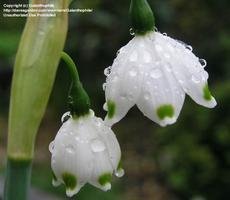
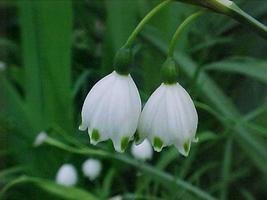
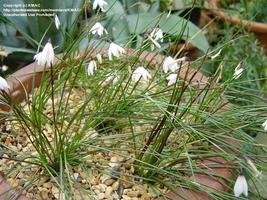
Leucojum vernum Leucojum aestivum Acis autumnalis
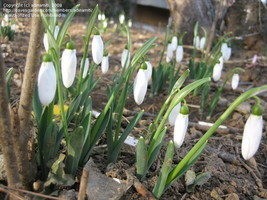 In our country, Galanthus nivalis pops up in February or sometimes in January, if the temperatures are high enough. They are the first flowers blooming in parks and gardens, being considered spring's harbinger. Snowdrops grow best in the forest where the countryside florists pick them up and form small bouquets, then sell them in the market or at the corner of the streets, carring them in wooden baskets.
In our country, Galanthus nivalis pops up in February or sometimes in January, if the temperatures are high enough. They are the first flowers blooming in parks and gardens, being considered spring's harbinger. Snowdrops grow best in the forest where the countryside florists pick them up and form small bouquets, then sell them in the market or at the corner of the streets, carring them in wooden baskets.
Some vendors sell snowdrops already planted in moss and placed in small baskets.
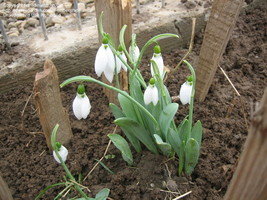
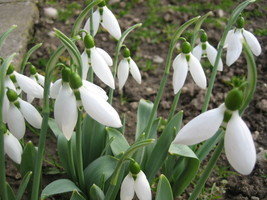
I had a great joy this February, when I received a cluster of blooming snowdrops with bulbs for my garden ! I planted them immediately, dividing them in two groups, trying to be very careful not to disturb or--worse, damage--their roots.
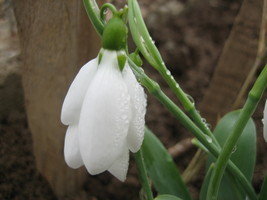
They have grown well, even when it snowed on them. The flowers closed up for a few days after planting, but then they opened up again and lasted until March.
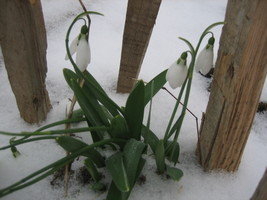
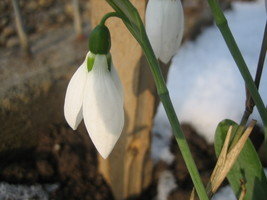
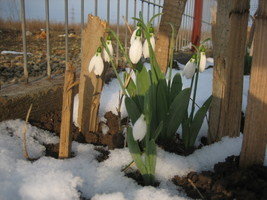
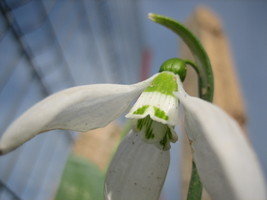
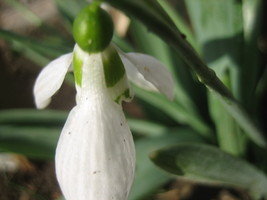
Now I know they are giant snowdrops (Galanthus elwesii), because their flowers are huge and they have a greenish line at the bottom of the inner tepals too.
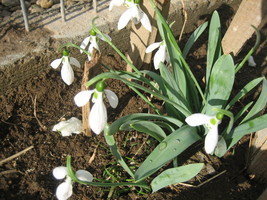
So, finally I have my snowdrops in the garden and they are beautiful! Now all my friends will see them and will know what a snowdrop looks like.
Many thanks to DG friends, Galanthophile, kniphofia, tigerlily and KMAC for the use their gorgeous pictures you see here.
For more information, access the Dave's Garden PlantFiles or check out this website.
[1] Wikipedia: http://en.wikipedia.org/wiki/Snowdrop
(Editor's Note: This article was originally published on April 24, 2009. Your comments are welcome, but please be aware that authors of previously published articles may not be able to promptly respond to new questions or comments.)
Copyright © www.100flowers.win Botanic Garden All Rights Reserved